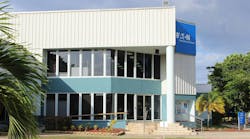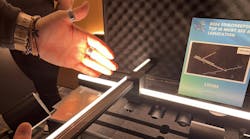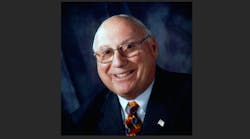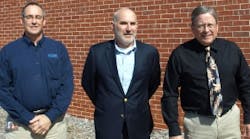While the construction and retrofit of K-12 schools this year remains in the doldrums in many markets because of local battles over bond issues, there's no doubt that long-term this remains one of the big-potential niches for electrical distributors and their customers.
Nationally, long-range enrollment trends are still tracking for steady growth through 2020, and in some markets — particularly in Sunbelt states — the anticipated increase in new students is nothing short of explosive and will require the construction of many more school buildings and related facilities. McGraw-Hill's 2012 Dodge Construction Outlook says construction professionals may also benefit from retrofits of aging facilities. School districts in many older population centers in the Northeast and Midwest that won't see any dramatic enrollment increases are saddled with buildings fast approaching their serviceable lifespan of about 40 years, and these facilities are ripe for retrofits.
Energy-service companies (ESCOs), which supply schools, universities, businesses and other municipal/government entities with a one-stop solution for the retrofit of aging and inefficient lighting, HVAC, windows, roofs and other building systems, long ago figured out that schools and universities are a lucrative market, and they have for years provided whole-building retrofit solutions through energy saving performance contracts (ESPCs) that guarantee payback in energy savings on the equipment installed. A 2012 report by Lawrence Berkeley National Laboratory, Berkeley, Calif., showed that K-12 projects account for 33% of all ESCO market activity, the largest single project niche. Other key niches for ESCOs include: state/local government (15%); federal government (14%); universities/colleges (12%); hospitals/healthcare facilities (8%); commercial offices (6%); industrials (4%); retail (2%); hotel/hospitality; and residential (both 1%).
The K-12 niche has been a particularly lucrative market for ConEdison Solutions Inc., Valhalla, N.Y., one of the largest ESCOs in the United States. Over the past few years, the company's energy engineers in its headquarters office and divisional offices in Chicago, Illinois; Burlington, Mass.; Cherry Hill, N.J.; Falls Church, Va.; Houston; Tampa, Fla.; Durham, N.C.; and Overland Park, Kan.; have helped many school districts save thousands of dollars in energy costs with whole-building retrofits.
The ConEdison Solutions team in Overland Park, Kan., just a few short miles away from Electrical Wholesaling's editorial offices, has more than 30 employees working in the office and remotely at job sites and has engineered quite a few retrofits for K-12 schools in Kansas and Missouri, as well as in other regions of the Midwest, over the past few years. Amy Nemeth, the office's director of operations, is a licensed mechanical engineer who has worked in the Overland Park office for both ConEdison Solutions, and for Custom Energy Services, which ConEdison Solutions acquired in 2008. She also worked for Black & Veatch, Overland Park, Kan., one of the nation's largest engineering firms, for 13 years before joining Custom Energy Solutions.
She said in an interview with Woman Engineer magazine that she joined the ESCO because she's, “very intrigued by engineering from the energy perspective, and how we, as a society, benefit from making smart choices about how we design and operate engineered systems.” She went on to say in that article, “At ConEdison Solutions, we give our clients the ability to use their energy savings as a revenue stream to help fund facility improvements that makes their facilities more sustainable and more cost-effective with up-to-date equipment.”
Nemeth told Electrical Wholesaling that every job the company works on has an electrical component so they are constantly working with electrical contractors. She says the best electrical contractors are knowledgeable about the latest energy-efficient electrical equipment and look at jobs with an eye for saving energy for the customer. Nemeth also says on some projects ConEdison Solutions will look for an electrical contractor that has engineering capabilities in-house, can do design work and generate some drawings. “We don't really compete against them,” she says. “We are acting more like the general contractor.”
When looking for an electrical distributor to supply a K-12 retrofit and other jobs, Nemeth says ConEdison Solutions wants a company with a strong local presence and timely service. “Depending on the project, a huge local inventory may or may not be a major factor,” she added.
Nemeth says her office spends quite a bit of time developing energy-saving performance contracts in the Midwest, Texas and occasionally in California and Wyoming for what's known as the MUSH market (municipal, state/local business, K-12 schools, universities and healthcare facilities). Her Overland Park location has honed a range of services for whole-building retrofits for the K-12 market that include but are not limited to facility audits; helping school districts identify local, state and federal sources of financing and grants, as well as utility rebates; meeting with school boards to educate them on energy saving performance contracts and a retrofit's return on investment; and working as a general contractor for a job. It's not at all unusual for ConEdison Solutions to help a school district trim 20% to 30% off of its annual electrical bill and to save school districts more than $200,000 annually in energy and non-energy related expenses from a retrofit.
In addition to designing and managing the installation of the lighting, occupancy sensors and lighting control system for a school, ConEdison Solutions' projects often include the installation of new air-conditioning systems, variable-speed drives, motors, roofs, ceilings, windows, boilers, chillers, energy-management system and low-flow water fixtures. Another office of ConEdison Solutions recently announced that it will be doing a photovoltaic (PV) installation in New Bedford, Mass., that will include the installation of solar panels on school buildings and public locations throughout the city that could save the city $10 million by 2033 and produce enough power to run about 1,500 homes.
The retrofit project that ConEdison Solutions managed for the Piper School District in Kansas City, Kan., is a good example of its approach. Piper is a small district serving approximately 1,900 students in a rapidly developing area of metropolitan Kansas City that several years ago needed to upgrade its facilities but saw a bond issue for a major expansion get soundly defeated by residents.
When the district's superintendent, Steve Adams, came to Piper in 2007, the school's A/C equipment was 17-18 years old, and many of the buildings needed energy upgrades and other structural improvements. He was able to win a smaller, $30 million bond issue for building improvements but needed to stretch those dollars even further. A conversation about performance contracting with the district's construction manager eventually led him to ConEdison Solutions (then Custom Energy Solutions) and they developed a plan to fund the project through an energy savings performance contract, where the school district would receive energy infrastructure improvements with a relatively low up-front cost. Under an ESPC, an ESCO such as ConEdison Solutions guarantees future energy savings to be generated by the improvements, which enables school districts to fund the costs of the improvements based on the savings.
Says Adams, “We have done well over $7 million of improvements. The neat thing about it is that we got much more out of it than we imagined we could by working with the ESCO. We replaced all of lighting fixtures, water fixtures and the HVAC system. We also got a football field through deferred savings, lighting on our sports fields, and technology infrastructure. All those things are very expensive to do, but through energy savings and deferred maintenance we got all that. We really stretched as $30 million bond issue with some other things into about a $40 million effort.”
Today, that retrofit project is providing the Piper School District with $70,834 in annual energy savings achieved through the program, plus an additional $185,667 in non-energy-related savings. As part of the program, the high school was renovated and expanded with a new 30,000 square-foot wing. The first phase of the project included installation of high-efficiency lighting, LED exit signs, occupancy sensors, an energy management system, low-flow water fixtures, voice-over-Internet protocol phone system, security system, and the football field turf and an eight-lane track. The second phase included remodeling work associated with the high school addition. These improvements included energy-efficient lighting upgrades with drop ceilings, new HVAC systems, and water-efficiency upgrades. The entire project was complete in Sept. 2009.
One interesting element of the lighting retrofit is that most of the lamps are either T-5 or compact fluorescents for interior lighting, and T-5 fluorescents for the parking lots. Danny Seymour, construction manager, and Mike Eckard, project manager, from ConEdison Solutions, said LEDs were not considered for interior general lighting applications or outdoor applications on the project, because at the time of the installation they believed the payback on LEDs was too long when compared to the more conventional lighting products for the job. Today, ConEdison Solutions does use LEDs for high-maintenance cost areas such as parking lots, high ceilings in industrial facilities and exit sign retrofits.
Another interesting element of the Piper School District job is that because of all the cost savings from the facility retrofit, Adams was able to convince the school board to install an all-weather football field and track to replace a much older field. An added bonus — when Piper's teams are not using the field, the school district rents it out to local soccer and football teams and a women's professional football team. “That football field is a gem,” says Adams. “The community takes a great deal of pride in it.”
Eckard said the new equipment and building systems are helping the district save money by doing away with unnecessary maintenance costs. The maintenance staff doesn't have to call in HVAC technicians to repair or service the air-conditioning units as often, and when they do need service, technicians utilize remote monitoring software to diagnose the problem before coming to the school. Says Ekard, “When your facilities are up to speed and are well engineered, you don't have to mess with them. The first year I was here there wasn't a week went by that there was not a big A/C issue,” adds Adams. “I can't count more than five issues all year with the new system.”
Ekard says a big part of selling a school board and other buying influences on an energy savings performance contract is convincing them that the guarantees for energy savings that come with each contract are a collaborative venture, and that ConEdison Solutions is there to back them up and fulfill their financial obligation if a project doesn't perform as specified. Adams says that on the Piper project it helped that a school board member at the time was in the construction business and understood how the contract worked. It can take others some time to wrap their minds around ESPCs, he says.
Meet the Parent: Con Ed at a Glance
Adams may have another big construction project on his hands soon if his plans for a new high school win community support. Some studies show that the Piper School District could one day have more than 10,000 students — a 400% increase from current enrollment levels — because of a massive amount of commercial construction nearby that will include a 4,000-employee office facility for Cerner and the expansion of the Legends development in Kansas City, Kan., which already includes a NASCAR track, casino, the T-Bones minor-league baseball stadium, the new Sporting KC professional soccer stadium and a large outdoor shopping mall.
With this kind of development in the backyard of its Overland Park office, you can see why Phil Collingwood, the general manager of ConEdison's Solutions' Midwest region since Aug. 2011, says that by some measures ConEdison Solutions' business is recession-proof. When the economy is good, he says customers will retrofit or upgrade their buildings systems for sustainability. But when they need to save money, they will look for ways to cut expenses and that energy is an easy place to cut. “It's just a different driver,” he said. “We should be able to do just as well in a good market as in a hard market.”
Consolidated Edison Inc. is one of the nation's largest investor-owned energy-delivery companies, with approximately $13 billion in annual revenues and $39 billion in assets, according to information in the company's 2011 annual report. It provides energy-related products and services to its customers through the following subsidiaries: Consolidated Edison Company of New York Inc., a regulated utility providing electric, gas, and steam service in New York City and Westchester County, N.Y.; Orange and Rockland Utilities, Inc., a regulated utility serving customers in a 1,350-square-mile area in southeastern New York State and adjacent sections of northern New Jersey and northeastern Pennsylvania; ConEdison Solutions, a retail energy supply and services company; ConEdison Energy, a wholesale energy-supply company; and ConEdison Development, a company that participates in infrastructure projects.
ConEdison Solutions is part of Con Edison's Competitive Energy Business division, which also includes ConEdison Energy and Con Edison Development. According to information in Con Edison's most recent annual report, these businesses include the sales and related hedging of electricity to wholesale and retail customers, sales of certain energy-related products and services, and participation in energy infrastructure projects. On Dec. 31, 2011, Con Edison's equity investment in its competitive energy businesses was $357 million and their assets amounted to $856 million.













